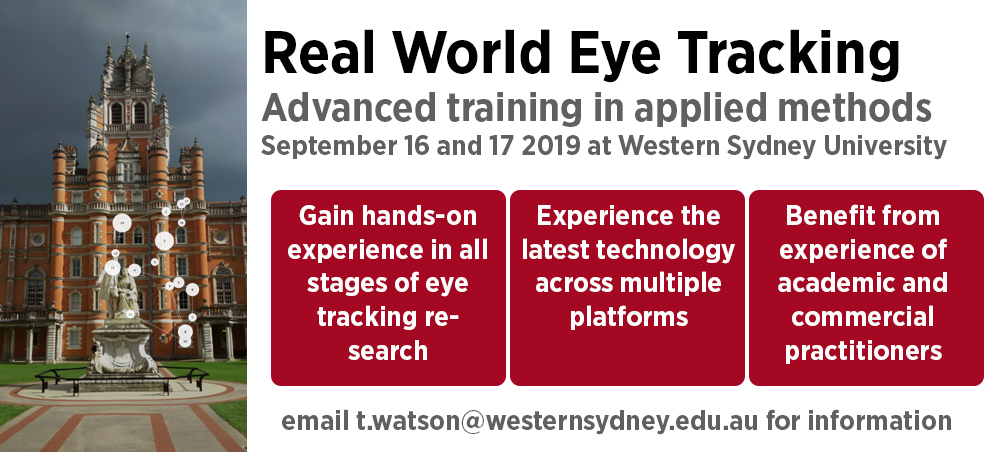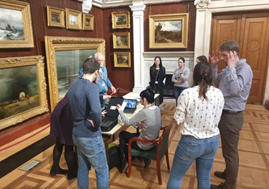Real World Eye Tracking Course 2019

The long-running Real World Eye Tracking course run by the Department of Psychology of Royal Holloway, University of London is coming to Sydney!
The School of Social Sciences and Psychology of Western Sydney University is pleased to host the 2 day, hands on, small group course.
When Monday 16th & Tuesday 17th September 2019
Where One Parramatta Square (169 Macquarie Street, Parramatta), Western Sydney University
Cost Industry participants $1050, Academic participants $750
Register here https://onestop.westernsydney.edu.au/OneStopWeb/SSSP_026
Why do you need to know about eye tracking?
From glasses you can use almost anywhere to laptops with them built-in and now augmented and virtual reality headsets - eye tracking is everywhere! But not all eye trackers are created equal, and to get the best out of this technology you need look around. Whether for simply knowing where a person looks or understanding cognitive states in high pressure environments, this is a technology you can’t afford to ignore.
Why we run this course
We believe you need some theoretical background to get the most out of eye-tracking, but we also recognise the value that comes from the hands-on experience of designing, running and analysing real studies. Our aim is to give you the confidence to dive in and save you from drowning when you do! No other course offers this range of cutting edge multi-platform systems in one place, without a sales-person in sight! Try things out, and see the results for yourself.
What you will learn
How to justify your use of eye tracking methods and understand the evidence they provide
Where to find further information when running your own projects
How to choose the right tools and begin running your own project
How to get the most out of your research through good design and great analysis
Course content
The course contains a mix of interactive lectures and small team project work supervised by an expert in the field. All attendees will experience running an eye tracking project from start to finish. You will also get to chat with experts and develop a feel for issues, independent of hardware and software platforms, from various research applications, including eye tracking in virtual reality.
Presenters
Dr Szonya Durant, Royal Holloway, University of London
Dr Tim Holmes, Royal Holloway, University of London
Prof Johannes Zanker, Royal Holloway, University of London
To find out more contact Dr Tamara Watson
Find the course on Twitter @rhuleyetracking
Course Outline
Day 1:
Introduction to eye tracking principles and applications
The underlying theory behind using eye tracking to inform us about mental processes such attention and decision making. Using theories of eye movements it will explain how the interpretation of measures such as eye position, fixation frequency/ duration/ location/ trajectory/ dynamics and pupil size can tell us about how people pay attention. It will explain the terminology used and discuss the implications of theories of attention for interpreting eye tracking data.
Practical considerations for different systems and software
In particularly in terms of the limitation in doing ‘real world eye tracking’ - the capabilities of remote and mobile devices and associated software. Considering the ease of extracting data using ‘off-the shelf’ vs bespoke software. We will discuss applications from shopper research, web design and print advertising for example. Participants are encouraged to contribute their own questions thinking about their own areas of research. Aspects relating to integration with other technologies such as virtual reality and separate biometrics measurements will also be explored in this session.
Design and recruitment
This session will discuss the importance of criteria for participants and considerations in designing and eye tracking experiment as well as ethical considerations in recording and handling data. It will address some important considerations for avoiding basic confounding factors in your design, by building on previous psychological research and discuss appropriate metrics for answering specific questions and address some of the problems in dealing with data collection in the real world, building on the extensive knowledge and experience gained over the years working with many companies as well as publishing scientific articles.
Mini projects set up and initial data collection
Before the start of the course we will collect information on. Participants will be split into small groups for the rest of the day according to their interests and level of experience, to run their own experiments. There will be four groups, which limits how well we can match participant’s individual focus, but they will get experience of all paradigms and platforms and the focus is on learning non-platform specific application. Each project is led by a different member of staff teaching on the course (Dr Tim Holmes, Prof Zanker, Dr Durant) to further enrich the student-senior expert interaction.
Each group works with one of the expert course tutors to set up and run an experiment on members of the group. The aim of this session is to provide hands-on experience in developing an eye tracking experiment to answer a given question, to gain some insight into issues of design and optimal development as well as an introductory experience using a particular eye tracking software and hardware set-up. Example past projects running in parallel include product placement in cinema, real world shopper behaviour, art appreciation and user experience. Project feedback, demos with Q&A Each group will explain their experimental set-up and data collection to the other groups and the equipment and set up for each demonstrated to all. Additional systems will be demonstrated in this session. This is the chance for participants to ask the course leaders about questions specific to their own interests.

Day 2:
Data preparation
This session is particularly relevant for mobile eye tracking and covers how to extract data in such a way as to be able to interpret it relative to real world regions of interest. The latest developments in automated coding will be demonstrated and evaluated as well as methods for creating dynamic regions of interest in the recorded sequences. This aspect of applied eye tracking is not trivial, but lies at the heart of effective use. This is also the part of the course that is most likely to be updated with new software developments.
Analysis in groups
Returning to mini-project groups to get hands-on with the data collected, putting it together to a final presentation of results, guided by the group leader from the expert course staff. The aim is to gain familiarity with analysis packages and to understand which measures might be used to answer what questions. This part forms most of Day 2 as we have found that it is worth investing the time to understand what the steps are in analysing data and this is best done by allowing participants to carry this out themselves with enough time.
Presentation and discussion with Q&A
Each of the groups presents their results in turn and there is group discussion about issues arising from the mini-projects. The aim is to demonstrate understanding of the issues and to have built confidence in using eye tracking to get results out. This is also a further chance for participants to ask the course leaders about questions specific to their own interests.

 Foundational Processes of Behaviour Research Laboratories Home
Foundational Processes of Behaviour Research Laboratories Home
